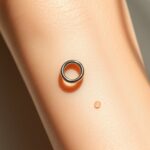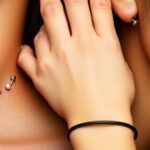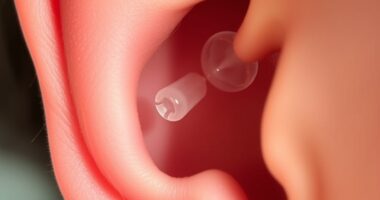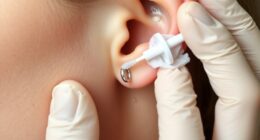Piercing migration and rejection happen when your body responds negatively to the jewelry, often due to improper aftercare, poor jewelry quality, or trauma. Your body may push the jewelry out or cause it to shift, risking additional complications. Proper hygiene, choosing high-quality materials, and avoiding unnecessary movement help prevent these issues. If you want to understand how to minimize rejection and promote healthy healing, you’ll find essential tips that can make a difference.
Key Takeaways
- Rejection occurs when the body perceives the jewelry as a threat, leading to migration or expulsion.
- Proper aftercare and hygiene significantly reduce the risk of infection and rejection during healing.
- Poor jewelry fit or low-quality materials can cause tissue trauma, increasing rejection chances.
- Excessive movement or trauma to the piercing site can trigger migration or rejection.
- Early detection and addressing signs of complications help ensure successful healing and prevent rejection.
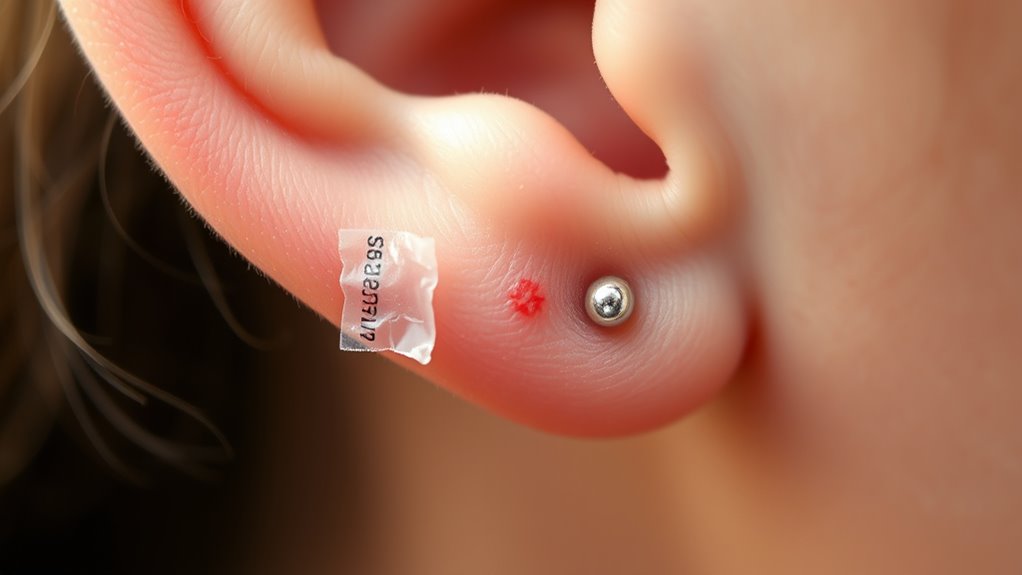
Piercing migration and rejection are common concerns for those who get body piercings, especially when the body responds negatively. These issues can happen unexpectedly, causing discomfort, aesthetic problems, or even the need to remove the piercing altogether. Understanding how to prevent migration and rejection starts with knowing the best healing methods and infection prevention techniques. Proper aftercare is essential in giving your body the best chance to accept the piercing and minimize complications.
Prevent migration and rejection with proper aftercare and infection prevention techniques.
When you get a new piercing, one of your top priorities should be following the recommended healing methods. This means keeping the area clean and avoiding unnecessary trauma. Clean the piercing twice daily with a saline solution or a gentle, fragrance-free cleanser. Avoid touching the piercing with dirty hands, and steer clear of any harsh chemicals or alcohol-based products, as they can irritate the tissue and slow healing. Using sterile or sanitized jewelry and tools during the healing process also plays a critical role. These practices help prevent infection, which can complicate healing and increase the risk of migration or rejection.
Infection prevention is another key aspect of successful piercing healing. Infection can cause swelling, redness, pain, and even pus, which may push the jewelry out or cause the body to reject it. To prevent infection, stay vigilant about hygiene and avoid exposing your piercing to dirty environments or harsh chemicals. Be cautious with swimming pools, hot tubs, or lakes during the initial healing phase; contaminated water can introduce bacteria that compromise the piercing. If you notice signs of infection, such as persistent swelling, unusual discharge, or increasing pain, consult a professional piercer or healthcare provider promptly. They can recommend appropriate treatment to prevent further complications. Additionally, choosing proper jewelry materials can significantly reduce the risk of rejection and irritation, as high-quality, hypoallergenic options are less likely to cause adverse reactions.
Choosing the right jewelry also helps in preventing migration and rejection. Opt for high-quality, hypoallergenic materials like surgical steel, titanium, or niobium. These materials minimize the risk of allergic reactions and tissue irritation. Avoid oversized or poorly fitted jewelry, as it can cause unnecessary movement and trauma to the piercing site, increasing the chances of migration. Remember, your body needs time to adapt; rushing the healing process or choosing inappropriate jewelry can lead to rejection.
Ultimately, successful healing depends on your commitment to proper aftercare and infection prevention. Be patient, follow the guidance from your piercer, and pay close attention to your body’s signals. If you notice any signs of trouble, take action early to address issues before they escalate. With careful care, you can reduce the risk of migration and rejection, ensuring your piercing heals beautifully and remains a part of your body for years to come.
Frequently Asked Questions
How Long Does Piercing Migration Typically Take to Resolve Naturally?
Piercing migration usually resolves naturally within a few months to a year, depending on your healing timeline. If the migration is minor and the piercing remains healthy, your body may gradually stabilize, leading to natural resolution. Keep in mind that individual healing varies, so monitor your piercing closely. Proper aftercare, patience, and avoiding unnecessary movement can help speed up the process and support a healthy healing timeline.
Can Lifestyle Changes Reduce the Risk of Piercing Rejection?
Yes, lifestyle changes can reduce the risk of piercing rejection. Studies show that over 20% of piercings reject due to improper care. By adopting good healing practices, like keeping the area clean and avoiding trauma, and choosing high-quality jewelry materials such as surgical steel or titanium, you minimize irritation. Avoiding unnecessary touching and reducing stress on the piercing also helps, promoting healthier healing and lowering rejection chances.
Are Some Body Areas More Prone to Migration Than Others?
Certain body areas are more prone to migration, especially earlobes due to their higher susceptibility, making them more likely to shift over time. Cartilage piercings, on the other hand, often experience migration because of less flexibility and thicker tissue. You should be aware that earlobe susceptibility varies based on your anatomy and lifestyle, which can influence how stable your piercing remains. Proper jewelry choice and aftercare also help minimize migration risks.
How Can I Tell if My Piercing Is Migrating Versus Healing?
Think of your piercing as a tiny traveler on a journey; is it wandering or just settling in? You can tell if it’s migrating by looking for signs like uneven movement, changes in position, or increasing discomfort. Healing indicators include reduced swelling, less pain, and a decrease in redness. If your piercing feels like it’s moving rather than healing, trust your instincts and consult a professional to avoid complications.
Does Age Affect the Likelihood of Piercing Rejection?
Age does impact rejection likelihood, with younger individuals often experiencing higher rates of rejection due to more active immune responses and faster healing. As you age, your body typically becomes less reactive, reducing rejection risk. However, personal health, skin type, and piercing location also influence rejection chances. So, while age plays a role, it’s not the sole factor—you should consider your overall health and piercer’s advice to minimize rejection risks.
Conclusion
So, here you are, obsessively checking your piercing, hoping it stays put. Ironically, the very act of caring might trigger migration or rejection. You try to prevent it, yet your body’s natural defense sometimes works against your desire for perfect adornment. Maybe, in the end, the best lesson is to accept that some things just aren’t meant to stay forever — a beauty mark turned fleeting trend. Embrace the impermanence; it’s the twist your piercing never saw coming.
Piecing together a life one day at a time, that’s me. I’m Rusty, and I love being editor-in-chief of creative piercing. It’s my passion to help others see their vision and bring it to life. When I’m not working or taking care of my family, you can find me reading a good book or eating pie (of course!).



